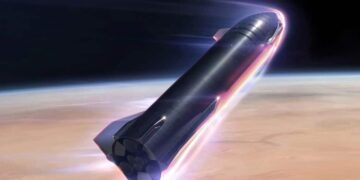The concept of quantum computers revolutionizing science has been a tantalizing dream for decades. Now, a groundbreaking idea has emerged from two tech visionaries: Sundar Pichai, CEO of Google, and Elon Musk of SpaceX. During a recent conversation, they proposed launching quantum computers into space. This ambitious vision could redefine quantum computing, leveraging space’s unique conditions to overcome earthly limitations.
Google’s Quantum Breakthrough: The Willow Chip
Google’s newly unveiled quantum chip, Willow, represents a significant leap forward in computational capability. In a recent demonstration, the chip completed calculations in five minutes that would take traditional supercomputers billions of years. This achievement highlights the immense potential of quantum computing to address problems that were once considered unsolvable.
However, quantum computers are constrained by environmental challenges on Earth. These systems require extreme isolation from electromagnetic interference and must operate at cryogenic temperatures. Maintaining such conditions on a large scale is daunting, limiting the deployment of quantum systems.
The Role of SpaceX’s Starship
Enter SpaceX’s Starship, a technological marvel designed to transport massive payloads for ambitious missions such as lunar colonization. During their discussion, Pichai proposed using Starship to launch quantum computers into orbit.
In space, these computers could operate free from electromagnetic interference and take advantage of stable, low temperatures. The synergy between Google’s cutting-edge quantum technology and SpaceX’s expertise in space transportation sets the stage for a revolutionary quantum cluster in orbit.
Why Space is Ideal for Quantum Computing
Space offers an unparalleled environment for quantum systems. The absence of atmospheric disturbances ensures minimal interference, while the natural coldness of space provides an energy-efficient solution for maintaining the cryogenic conditions required by quantum chips.
These factors make orbit an ideal location for large-scale quantum systems, enabling researchers to push the boundaries of computational capability without the environmental constraints found on Earth.
Applications of Quantum Computers in Space
The potential applications of space-based quantum systems are vast and transformative:
1. Climate Modeling
Accurate climate models are critical for addressing global warming. Quantum computers could analyze vast datasets with unprecedented speed, providing insights into complex environmental systems and enabling more effective strategies to combat climate change.
2. Medical Research
Space-based quantum computing could revolutionize drug discovery and medical research by simulating molecular interactions at an atomic level. This capability could lead to breakthroughs in curing diseases and developing personalized medicine.
3. Materials Science
Quantum systems could accelerate the discovery of new materials, essential for advancements in energy storage, electronics, and aerospace engineering.
Challenges and Feasibility
While the vision is compelling, significant hurdles must be addressed.
Technical Challenges
Launching quantum systems into space involves ensuring their stability during rocket launches and subsequent operation in orbit. Even minor disturbances could disrupt quantum coherence, rendering computations unreliable.
Cost and Logistics
The financial investment required to deploy and maintain space-based quantum systems is substantial. Collaboration between tech giants like Google and SpaceX could mitigate these costs, but the economic feasibility remains a question.
Ethical and Security Concerns
The deployment of advanced technologies in space raises ethical questions and security risks. Ensuring that space-based quantum systems are used responsibly and securely is paramount.
Elon Musk’s Vision Beyond Quantum Computing
Elon Musk’s ambitions extend beyond quantum systems. He envisions leveraging space for broader technological and energy solutions.
1. Solar Energy Expansion
Musk emphasized the potential of harnessing solar energy more effectively, proposing large-scale solar farms in deserts to increase energy capture.
2. Dyson Spheres
Musk also hinted at future technologies like Dyson spheres—structures designed to capture the sun’s energy on a massive scale.
The Path Forward
The collaboration between Google and SpaceX represents a new frontier in technological innovation. Turning the concept of space-based quantum computing into reality will require:
1. Prototyping and Testing
Developing and testing quantum systems capable of withstanding the rigors of space travel.
2. Infrastructure Development
Creating orbital platforms or satellites equipped to host quantum clusters.
3. Policy and Collaboration
Establishing international agreements and collaborations to ensure the responsible use of space-based technologies.
What This Means for the Future
The idea of quantum computers in space represents a bold step toward solving humanity’s greatest challenges. By combining Google’s expertise in quantum computing with SpaceX’s spacefaring capabilities, Pichai and Musk are charting a course for a future where innovation knows no bounds.
From revolutionizing scientific research to addressing global issues like climate change and energy sustainability, the potential impact is immense. The journey ahead is challenging, but the possibilities are too transformative to ignore.
Conclusion
Quantum computers in space might sound like science fiction, but it’s a vision grounded in cutting-edge technology and forward-thinking collaboration. As Sundar Pichai and Elon Musk push the boundaries of what’s possible, they remind us that the future belongs to those bold enough to imagine it.
The journey toward realizing space-based quantum systems is just beginning, but its potential to revolutionize technology, science, and humanity’s future is extraordinary.



















